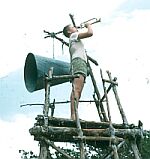 |
Facilities |
 |
Facilities |
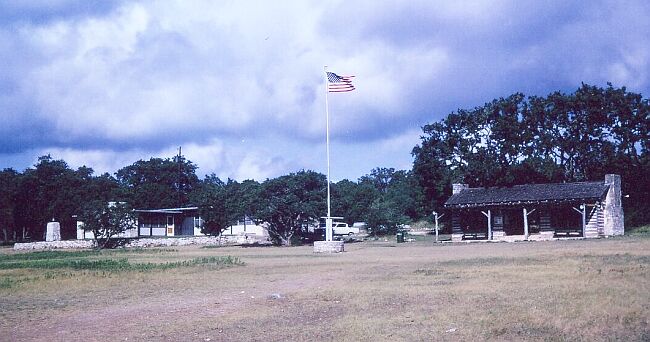
Camp Tom Wooten in 1966.
On the left is the dining hall and on the right is the log cabin.
| One of the most famous
features of Camp Tom Wooten has always been the log cabin. Here it
is shown as it was in 1966.
It has always housed the office, and at times it has been the first aid lodge, the trading post and sleeping quarters for one or two staff members. |
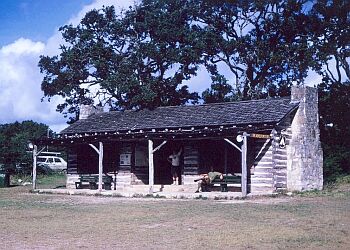 |
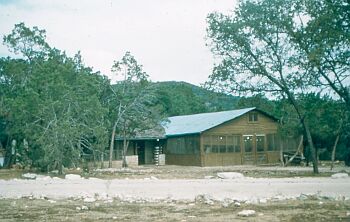 |
This is a rare photo
of the old dining hall that was used up into the late 1950s. The
kitchen was on the left of an "L." The eating section was on the
right and was screened in as shown in this photo.
In 1959, they converted the old dining hall to a combination trading post, warehouse, recreation area (covered) and central shower. The summer camp staff stayed in tents behind the facility. |
| Here is a photo of the
inside of the dining hall. Note that there was not much elbow room
due to the size of the hall and the number of kids needing to eat.
Did I mention that it was also hot when there was no breeze due to the
metal roof. That does not seem to prevent these Scouts from eating.
This photo was taken in the evening by evidence of Scouts wearing their
uniforms.
Note the single light bulb. In the Fall of 1958, Alpha Rho Chapter of Alpha Phi Omega Fall Pledge Class razed the old building and saved all usable material. |
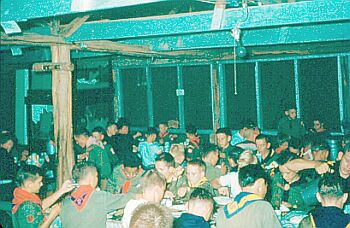 |
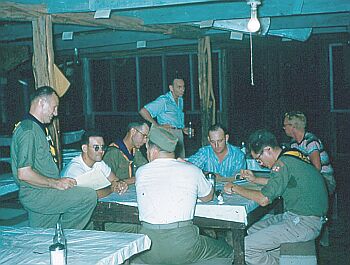 |
Here you see the leaders
planning their program for the week under the direction of the Program
Director. This gives you a better picture of the tables now that
the Scouts are all in their campsite and sound asleep. Sure, you
believe that don't you. John Montgomery, Camp Director, is leading
the discussion. He is standing up on the left with one foot on a
bench.
The camp always had problems with Scouts, at night, throwing rocks at other campsites and pulling up tent stakes. It seems that was more common in those days than it is today. Well, maybe not. |
| Here is the trading post
that was moved from the log cabin to the kitchen part of the old dining
hall. The old diddling hall was opened up and turned into a craft
area as well as the quartermaster.
Trading post is on the left and the craft area is on the right with the totem pole. The quartermaster was to the right of the trading post and behind the craft area on the same slab. The staff restroom facilities were located on the same slab just behind the trading post. |
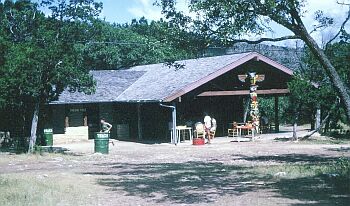 |
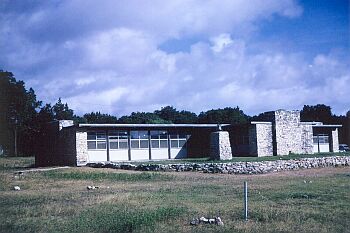 |
Following a Capital Funds Drive by the Capital Area Council in the early 1950s, a new dining hall was built in 1957, in time for summer camp, following all the then National Engineer's Design of the Boy Scouts of America. There were three fire places in the dining hall. The staff ate in the wing shown in this photo. You can see one of the two entrances to the dining hall where the two wings meet. |
| The dining hall still exists and is now part of the clubhouse for the Tennis Club located on the site of the former Camp Tom Wooten.. | 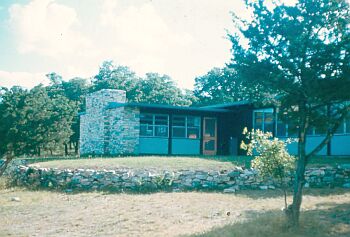 |
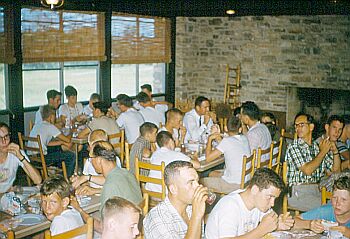 |
Here is the inside of
the new dining hall. Still not air-condition or fans but it was much
cooler thanks to the windows and insulated ceiling. This is a noon
meal, evidence by the lack of Scout uniforms. You can see one of
the fireplaces at the end of the room.
In 1958, they camped 1,346 during summer camp. That was a 30% increase over 1957. |
| When this photo was taken,
it was the First Aid Lodge. Prior to that time, the First Aid station
was located on the right side of the log cabin. You can see the wash
stand in the back of the structure to the right of the building.
There use to be an outdoor shower there too. In 1964, the building became
the nature/conservation center and the First Aid station was moved back
to the log cabin.
The only thing in the First Aid Lodge, besides a couple of beds and a table and chair, was lots and lots of scorpions. At night one could shine their flashlight up to the rafters and see them crawling everywhere. Rock buildings were noted for housing the critters. |
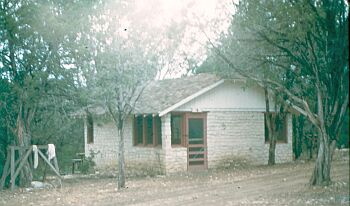 |
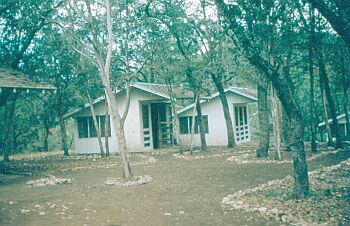 |
This campsite was located just above the swimming pool and overlooked Bull Creek. The shelters were made of wood and had screening. This made them a favorite place to camp and be protected from the rain, as long was it was not blowing, and mosquitos. Over the years, the rain washed the dirt away around the concrete floors and one would have to be careful stepping off them. Note the neat rock work on the trails. Campsites inspections were based in part on how you improved your campsite. Rock was plentiful so making neat trails out of them was a popular way to earn points. |
|
This campsite was located on the other side of the open field from the one above. It was made of rock and had the same features as the Sam Houston Campsite. There was also a Scoutmaster's cabin behind the shelters. Later, this cabin was used by the senior staff. Their beds were lined up along one side of the room. One night, the staff filed in very quietly and threw buckets of water all over the Program Director, whom the did not like. Needless to say, it was a very tense morning at the "A" Building. |
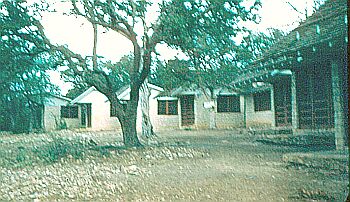 |
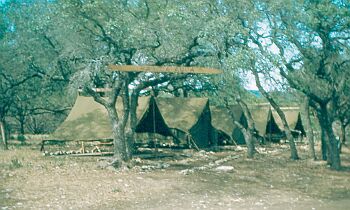 |
This was another popular campsite, although it was a tent campsite but had wooden platforms. It was off the beaten path and had lots of shade. You can see the style of tents provided the troops at this time. All the campsite were named after famous men of the War for Independence of Texas. Two others that come to mind were Bowie and Travis campsites. |
| Here is a tent in another campsite. Note the extra rock work in front of the tent and the patrol flags flying. This campsite was located just behind the Camp Ranger's home and was the first campsite you came to after leaving the big field known as the Parade Ground. These same tents were used in the staff area too. | 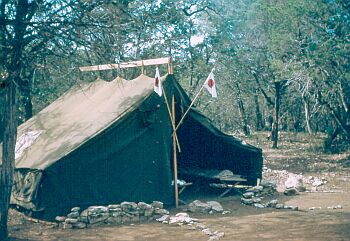 |
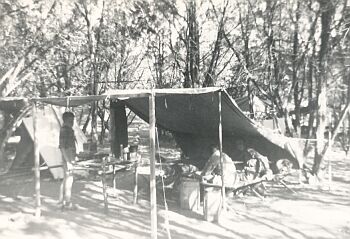 |
Later, all the tents were replaced with baker tents. The camp, at one time, owned 100 baker tents and 200 cots. The Order of the Arrow kept the cots repaired by replacing about 100 covers each year. The cots usually ripped by too many people sitting on them at one time. |
| The Camp Ranger's home
was one of the first buildings built on the property. Shown in this
photo is the home with Richard E. and wife Grace Lee, Camp Ranger, starting
in November 1953 - May 1957.
Later, when Richard "Dick" Givens became Camp Ranger the house was given a work over. The original electrical consisted of one circuit that ran through all the rooms, each room having a single light bulb hanging from the ceiling with a pull chain to turn it off and on. The new wiring added electrical plugs in each room and separate circuits in the kitchen. New kitchen cabinet and counters were also added. One interesting find while rewiring the house was that the wall studs were turned sideways and there was no insulation in the walls. |
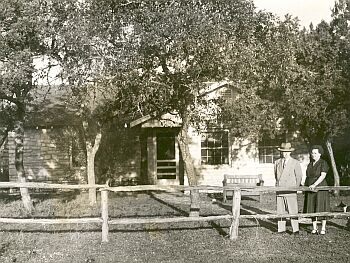 |
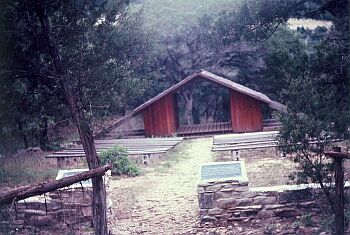 |
The chapel, located behind the Trading Post was a late addition to the camp. If we remember correctly, it was in memory of Homer A. Garrison. We are unable to read the dedication plaque located at the entrance to the chapel. |
| This building was located in the staff area behind the Trading Post and is believed to be the Staff Lounge. There is a washing machine stored in the building that was probably hooked up outside the staff shower which was on the back of the Trading Post. | 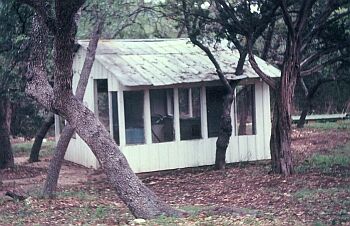 |
|
| Home | Aquatics | Program | Other Photos | Other Photos Yet | Patches | Staff | Promotion | OA | APO | | Map | Lone Star Trail | Pack & Paddle | Training | Remembrances | Provisional Troop | | Professional Staff | A. C. "Unk" Love | |